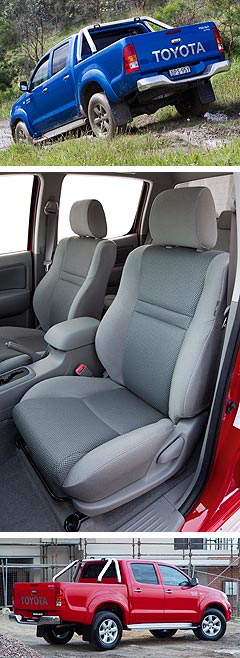First drive: Toyota improves HiLux breed
BY MATHIEU RAUDONIKIS | 10th Nov 2010

In 2009 sales of utes, both 4x2 and 4x4 combined, accounted for 16.4 per cent of the total new vehicle market and were second only to small cars with 22.8 per cent.
HiLux accounted for close to half of those sales with a 49.7 per cent share or 38,457 units, making it Toyota’s top-selling nameplate and second only to Holden’s Commodore in outright vehicle sales in Australia.
It’s a similar story in 2010 with sales to the end of October showing utes sales making up 14.9 per cent of the market behind small cars’ 23.1 per cent share and HiLux staking 51.5 per cent of the total sales. HiLux has 25.1 per cent of the 4x2 ute market and 26.4 per cent of 4x4 utes.
With such dominance of the sector you might wonder why Toyota would need to lift its game but its biggest competition is coming from Nissan Navara, which has 20.9 per cent of the 4x4 ute market so far this year with its two-pronged attack. Nissan sells more diesel double-cab 4x4 utes than anyone else, including HiLux.

With the increasing popularity of double-cab 4x4 utes as family and recreational vehicles and the fact that Navara outdoes HiLux here, it’s no surprise to find that Toyota has given its SR5 double-cab HiLux first pick of the new equipment.
This is set to make the ute more appealing to the family buyer for who safety is more of a consideration than perhaps the tradie who might look to reliability and value as more important priorities.
One-tonne utes still fall way behind 4x4 wagons and passenger cars in terms of passive and active safety equipment. They remain based on light truck construction with separate chassis, live rear axles, leaf springs and drum brakes, and the level of equipment such as electronic chassis controls and airbags is limited.
Mitsubishi has lead the way to safer utes by including full-time all-wheel-drive and electronic traction and stability control on its Triton models and Nissan has recently followed suit with traction and stability control on the D40 Navara.
The number of airbags has grown from a single unit for the driver in base-model tradie variants to dual front bags with side and curtain airbags for the rear passengers. ABS is now common in the ute class where it was unknown there not so long ago.
Toyota has followed this lead, giving the Hilux SR5 turbo-diesel 4x4 a raft of safety features including traction and stability control, side and curtain airbags in addition to driver and passenger bags, and upgrading the already standard ABS to include brake assist and electronic brake-force distribution.
On other vehicles in the extensive HiLux range, the price of the ABS option has been halved to $400 while on 4x2 models where it is offered as a package with a limited-slip differential, the package price has dropped from $1000 to $700.
The ABS option pack on SR HiLux models has been expanded to include curtain airbags and sports-style buckets seats for the driver and front passenger, fitted with side airbags, while the price remains at $800.
Aside from these safety additions the specifications remains much the same. The only visual change on the SR5 4x4 is the upgrade from the unusual 15-inch alloy wheels to 17-inch alloys wearing 265/65 R17 tyres.
As the top-spec model in the HiLux range the SR5 comes with a reasonable level of equipment considering it’s a light truck. Standard equipment includes air-conditioning, power steering, cruise control, power windows, mirrors and door locks, trip computer, leather wrapped steering wheel and shift knob, audio and cruise control functions on the steering wheel and an audio system with UBS input and Bluetooth phone connectivity.
Engine choices in the 4x4 models are limited to either the V6 petrol or four-cylinder turbo-diesel engines the 2.7-litre petrol four is available in 4x2 models only. The 3.0-litre common-rail turbo-diesel is the popular choice, offering 126kW of power at 3600rpm and 343Nm of torque at 1400rpm. Diesel consumption is quoted at 9.3L/100km and the transmission choice is either a five-speed manual or four-speed auto.
The 4.0-litre V6 puts out 175kW at 5200rpm and 342Nm at 2400rpm while delivering a claimed 13.1L/100km on the combined ADR 81/02 cycle. The petrol V6 can be optioned with either a five-speed manual or auto transmission.
It’s worth remembering that the V6 powered HiLux so far is not equipped with the new safety features, which includes traction control, so its only traction aid is a rear limited-slip differential.
The HiLux SR5 double-cab diesel is priced at $53,690 for the manual and $55,690 for the auto.
Often called unbreakable, the HiLux trades on its long history of rugged reliability and many will take this into account when paying more for the Toyota than they would for a similarly equipped ute from another manufacturer. However, quality problems and massive recalls of Toyota vehicles world-wide have buyers questioning Toyota’s good reputation and Hilux hasn’t escaped.
In September Toyota Australia issued a recall on 4x4 HiLux models built between January 2005 and February 2010 to address a possible fault in the rear drive shaft centre bearing. Almost 20 cases of the fault were reported in Australia with just the one incident, although no injuries resulted from it.
Toyota took the preventative measure of recalling the affected vehicles to have the centre bearing checked.